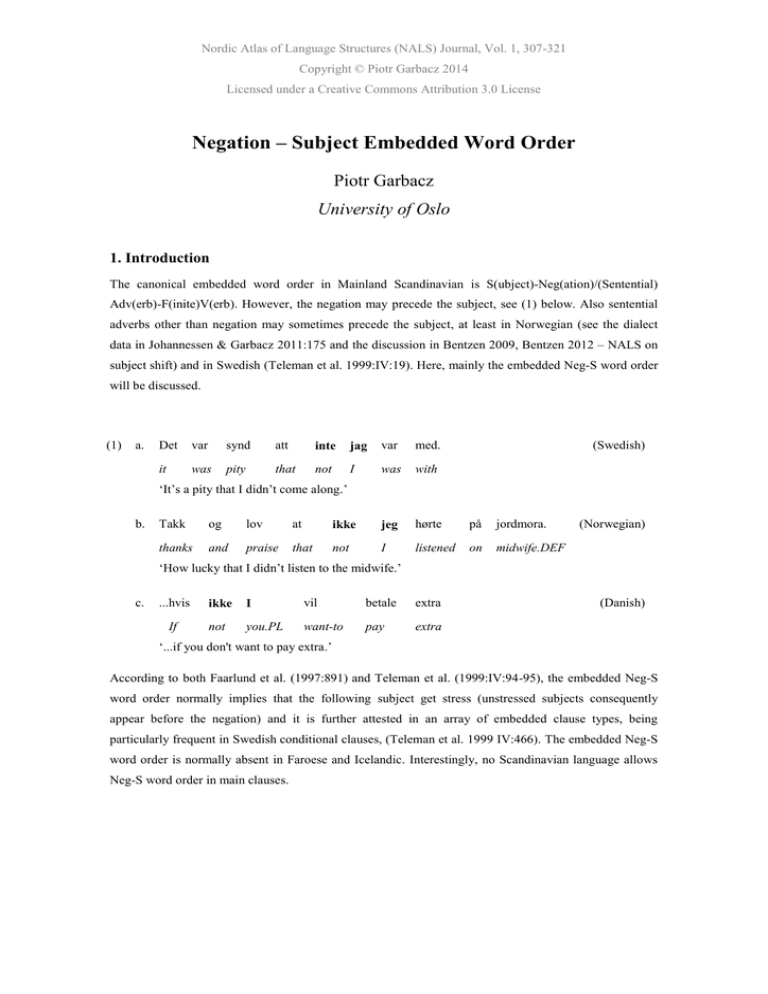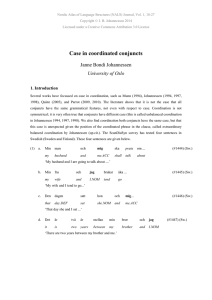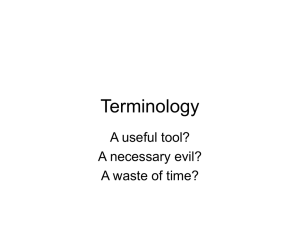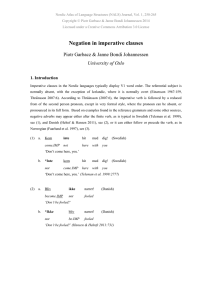Negation – Subject Embedded Word Order
advertisement

Nordic Atlas of Language Structures (NALS) Journal, Vol. 1, 307-321 Copyright © Piotr Garbacz 2014 Licensed under a Creative Commons Attribution 3.0 License Negation – Subject Embedded Word Order Piotr Garbacz University of Oslo 1. Introduction The canonical embedded word order in Mainland Scandinavian is S(ubject)-Neg(ation)/(Sentential) Adv(erb)-F(inite)V(erb). However, the negation may precede the subject, see (1) below. Also sentential adverbs other than negation may sometimes precede the subject, at least in Norwegian (see the dialect data in Johannessen & Garbacz 2011:175 and the discussion in Bentzen 2009, Bentzen 2012 – NALS on subject shift) and in Swedish (Teleman et al. 1999:IV:19). Here, mainly the embedded Neg-S word order will be discussed. (1) a. Det var synd att inte jag var med. it was pity that not I was with (Swedish) ‘It’s a pity that I didn’t come along.’ b. Takk og lov at ikke jeg hørte på jordmora. thanks and praise that not I listened on midwife.DEF (Norwegian) ‘How lucky that I didn’t listen to the midwife.’ c. ...hvis ikke I vil betale extra If not you.PL want-to pay extra (Danish) ‘...if you don't want to pay extra.’ According to both Faarlund et al. (1997:891) and Teleman et al. (1999:IV:94-95), the embedded Neg-S word order normally implies that the following subject get stress (unstressed subjects consequently appear before the negation) and it is further attested in an array of embedded clause types, being particularly frequent in Swedish conditional clauses, (Teleman et al. 1999 IV:466). The embedded Neg-S word order is normally absent in Faroese and Icelandic. Interestingly, no Scandinavian language allows Neg-S word order in main clauses. Negation – subject embedded Garbacz NALS Journal 2. Results 2.1 Nordic Syntax Database (NSD) The Neg-S embedded word order was tested in Swedish, Danish and Norwegian, cf. (2) and (3) below. (2) a. Vi we spikade nailed fast tavlan firmly picture för att for inte that den not it skulle ramla shall fall DEF Ner (#866) (Swedish) Down INF ‘We nailed the picture (to the wall) so it wouldn’t fall down.’ b. Så Limte vi den til hylla then Glued we it for att ikke den skulle falle ned. to shelf.DEF for that not it should fall (#866) (Norwegian) down ‘Then we glued it onto the shelf so that it wouldn’t fall down.’ c. Så hæftede vi den til hylden then Glued we it for att ikke den skulle falde ned. to shelf.DEF for that not it should fall (#866) (Danish) down ‘Then we glued it onto the shelf, so that it wouldn’t fall down.’ (3) a. Det var på den tiden då inte vi hade TV/bredband (#869) (Swedish) it was on the time.DEF when not we had TV/broadband ‘It was back in those days when we didn’t have TV/broadband.’ b. Det var dengang da ikke vi hadde fjernsyn. it was That when not we had TV (#869) (Norwegian) .time ‘It was back in those days when we didn’t have television.’ c. Det var dengang da ikke vi havde fjernsyn. it was that. when not we had TV/broadband time ‘It was back in those days when we didn’t have TV/broadband.’ 308 (#869) (Danish) Garbacz Negation – subject embedded NALS Journal The embedded Neg-S word order in the test sentences (2c) and (3c) is never accepted in Denmark, while (2a) and (3a) are judged as grammatical in almost all the Finnish locations and in the majority of the Swedish ones. In Norway the acceptability judgements vary between the sentence (2b) and (3b). The sentence (2b) is generally accepted by more informants compared to (3b), and the positive judgements come mostly form Sogn og Fjordane, Møre og Romsdal, Trøndelag, and Nordland. (2b) is rejected by the vast majority of informants from Southern and Eastern Norway in addition to the northernmost province of Finnmark. (3b) is only seldom judged as grammatical in Norway (Aremark in Østfold, Kristiansand in Vest-Agder, Kalvåg and Luster in Sogn og Fjordane, Skreia in Oppland, and Namndalen in NordTröndelag). This is shown in Map 1 and Map 2 below. Map 1: Embedded Neg-S word order in Swedish, Norwegian and Danish (#866: Vi spikade fast talvlan för att inte den skulle ramla Ner. ‘We nailed the picture (to the wall) so it wouldn’t fall down.’/Så limte vi den til hylla for at ikke den skulle falle ned. ‘So we glued it onto the shelf so it wouldn’t fall down.’) (White = high score, grey = medium score, black = low score). 309 Garbacz Negation – subject embedded NALS Journal Map 2: Embedded Neg-S word order in Swedish, Norwegian and Danish (#869: Det var på den tiden då inte vi hade TV/breband. ‘It was back in those days when we didn’t have TV/broadband.’) (White = high score, grey = medium score, black = low score) The embedded Neg-S word order was broadly tested in Denmark in clauses of reason, (2c) above, concessive clauses, (4), and that-clauses embedded under a factive predicate, (5a), under a strong assertive predicate, (5b), and under a non-asserted, non-factive predicate, (5c). The general result is that this word order is rejected in these embedded clause types, with the exception of Århus, where the sentence #1336 is accepted and Falster where the sentence #1326 is judged as grammatical, see Map 3 and Map 4. 310 Negation – subject embedded Garbacz (4) a. Jeg har tænkt mig at tage med til festen NALS Journal selvom ikke du kommer. (#1326) (Danish) I have thought me to take with to party.DEF even.if not you come ‘I have been thinking about going to the party, even if you won’t come.’ b. Det sjove er at småknægte på (#1336) (Danish) the fun is that children on 10-12 år godt kan selvom ikke 10-12 years well can although not de har prøvet det før. they have tried it before ‘The funny thing is that ten-twelve year-old children can do it although they haven’t tried it before.’ (5) a. Godt ikke vi kørte i grøften. good not we drived in ditch.DEF (#1324) (Danish) ‘It was fortunate that we didn't drive into the ditch.’ b. Han sagde at ikke han ville. (#1333) (Danish) he said that not he wanted-to ‘He said he didn’t want to.’ c. Det kan godt være ikke jeg har hørt det før. it can well be not I have heard it before ‘It is possible that I haven’t heard it before.’ 311 (#1338) (Danish) Garbacz Negation – subject embedded NALS Journal Map 3: The acceptance of test sentences #1326 and #1336 in Denmark (Blue = places where #1326 has been judged as grammatical, grey = places where #1336 has been judged as grammatical) Map 4: The acceptance of test sentences #1324, #1333, and 1338 in Denmark (Blue = places where #1324 has been rejected, grey = places where #1333 has been rejected, black = places where #1338 has been rejected) Further, the embedded Neg-S word orderin Danish was tested in embedded questions, (6), relative clauses, (7), in conditional clauses (8), and in temporal clauses (9). The test sentences in (6) and (7) have been rejected univocally, while the sentences in (8) and (9) have been accepted in almost all the Danish locations (with the exception of #1330 that has been rejected in Falster), see Map 5 below. 312 Negation – subject embedded Garbacz (6) a. NALS Journal Han spurgte hvorfor ikke hun kom til tiden. (#1331) (Danish) he asked why not she came to time.DEF ‘He asked why she didn’t come on time.’ b. Han spurgte hvem ikke der var kommet. he asked who not there was come (#1332) (Danish) ‘He asked who hadn’t arrived.’ (7) a. Jeg siger selvfølgelig ikke noget I say of.course not som ikke jeg må. anything that not I (#1337) (Danish) must ‘Of course, I don’t say anything that I don’t have to.’ b. De ting ikke han kunne sælge herhjemme, kunne han tage til København med. (#1339) (Danish) the things not he could sell around.here could he take to Copenhagen With ‘The things he couldn’t sell around here, he could bring to Copenhagen.’ (8) Jeg bliver vred hvis ikke du gør det nu I become angry if not you do it now umage når ikke (#1330) (Danish) ‘He will get angry if you don’t do it now.’ (9) Hvorfor skulle han gøre sig du gør din del (#1334) (Danish) why should he do REFL bother when ‘Why should he bother if you don’t do your part?’ 313 not you make your part Negation – subject embedded Garbacz NALS Journal Map 5: Neg-S word order in Danish conditional clauses (#1330) and temporal clauses (#1334). (Blue pins = places where #1330 gets a high score, grey pins = places where #1334 gets a high score). Finally, the embedded Neg-S word order was tested in two temporal clauses, (10) and (11), and in a purpose clause (12). The purpose clauses have got the most positive judgements from the Danish informants. (10) Sålænge ikke frosten er gået af as.long.as not frost.DEF is gone of Jorden kan det ikke betale sig it not ground.DEF can At plante ud. To plant out pay (#1328) (Danish) REFL ‘As long as the soil is frozen, there is no point in planting.’ (11) Når ikke der var flere øller tillbage gik de hjem. when not there was more beers left went they home ‘When there were no beers left, they went home.’ 314 (#1335) (Danish) Negation – subject embedded Garbacz (12) Sådan må vi hellre gøre det for ikke det NALS Journal bliver for forvirrende (#1341) (Danish) Such must we rather do it for not it becomes too confusing ‘We rather have to do it in this way, so that is doesn’t get too confusing.’ Map 6: Neg-S word order in Danish (#1328; #1335; #1341). (Black pins = places where #1328 gets a high score, blue pins = places where #1335 gets a high score, grey pins = places where #1341 gets a high score). 2.2 Nordic Dialect Corpus (NDC) In the NDC, the embedded Adv-S word order (including the embedded Neg-S word order) is broadly attested in Norway, Sweden, Denmark, and in the Faroe Islands, see Map 7. 315 Negation – subject embedded Garbacz NALS Journal Map 7: Attestations of the embedded Adv-S word order in Scandinavia (White = places of attestation). However, as can be seen in Map 7, the embedded Adv-S word order is not found in the following two Norwegian areas: (1) parts of Rogaland, Aust-Agder and Telemark and (2) parts of Møre og Romsdal and Sør-Trøndelag, as well as in big parts of Central and Northern Sweden neither in Finland. The fact that this word order is unattested in parts of Norway may indicate the existence of an islogloss, but the lack of hits in parts of Sweden and Finland has rather to do with the lack of transcriptions and/or lack of proper tagging of the raw data material from these regions in the NDC. The embedded Adv/Neg-S word order is thus, as expected, found in the spontaneous data from Norway, (13) and Sweden (14), but it is also present in the Danish and the Faroese part of the NDC. (13) you du are E så so lat lazy att that ikkje du giddar gå not you have walk i fra Sannvikstårrge from Sandvikstorget (Nor.) the energy to ‘You are so lazy that you don’t even have the energy to walk from Sandvikstorget.’ (bergen_03gm) 316 Negation – subject embedded Garbacz (14) NALS Journal då kan hända att inte en får sitta när en kommer fram then can happen that not one gets sit when one comes there (Swedish) ‘Then it can happen that you can’t get a sit, when you have got there.’ (leksand_ow3) In contrast to what the results from the judgments indicate, the embedded Neg-S word order is not restricted to conditional clauses in Danish in the NDC data, but appears also in temporal clauses (15a) and concessive clauses (15b). Such clauses are normally judged as ungrammatical in the NSD, cf. Section 2 above. (15) a. Når ikke man har børn # så... When not one has children # so Danish 'if one doesn’t have children, then...' (falster1) b. selvom inte det er ret langt herfra Danish although not it is right far here.from 'although it is not far from here' (harbooere_48) Interestingly, in the Faroese part of the NDC, there are a couple of examples of the embedded Neg/Adv-S word order in conditional clauses (26a,b) and in temporal clauses clauses (16c). The places of attestation are shown in Map 8. (16) a. viss ikki babba kom norð eftir mær if not daddy came north after me Faroese '...if my daddy didn’t follow me to the north.' (sandur_s9) b. viss nú eg tosi við ein ein ein ein náttklubbaeigara... if now I speak with a a a a night-club-owner Faroese 'if I then speak with a night club owner...' (torshavn_t34) c. hvussu var tað tá jú tað er broytt How was it when then it is changed 'how is it, when it is changed.' (fuglafjoerdur_f25) 317 Faroese Negation – subject embedded Garbacz NALS Journal Map 8: Attestations of the embedded Adv-S word order in the Faroe Islands (Black = places of attestation). As stated above, in Norwegian, the Adv/Neg–S word order is not only found in various clause types, but also with various adverbials preceding the subject, (17), and with both stressed subjects and unstressed subjects, (18a) and (18b) respectively. (17) a. så velldi rart att bærre Ål sjil se ut så velldi so very strange that only Ål differs REFL out so much (Norwegian) 'how very strange that it is only Ål that is so different' (aal_01um) b. e Lura på åmm jeddna dæi æu hadde oenninga I wonder on whether possibly they also had o-ending.DEF ‘I wonder if they might also have had the o-ending.' (gjesdal_03gm) c. visst No vi finn ett dyr somm e sykt if now we find an animal that is sick 'if we now find an animal that is ill' (kaafjord_01um) 318 (Norwegian) (Norwegian) Negation – subject embedded Garbacz (18) a. ja æ velldi fint att ikke jæ ær de yes is very nice that not I am it NALS Journal (Norwegian) 'Yes, it is very good that I'm not like that.' (fredrikstad_02uk) b. ...att That ikke mann får denn på plass not one get it on place (Norwegian) 'that it cannot be finished' (kirkenes_03gm) 3. Discussion The Neg-S embedded word order is generally judged as grammatical by, and attested in the speech of, the informants speaking Norwegian and Swedish. In Danish, the word order has been judged as grammatical in conditional clauses and, to some extent, in purpose clauses. It has also been attested in Danish conditional, temporal and consessive clauses in the NDC. The embedded Neg-S word order was neither tested on the Faroe Islands nor on Iceland, but it has been attested in the Faroese material. Finally, it is apparent that not only negation, but also other sentential adverbs, can be placed in front of the subject in an embedded clause in Norwegian and Faroese. 3.1 Embedded Neg-S word order and the subject Both Teleman et al. (1999:IV:94-95) and Faarlund et al. (1997:891) claim that the embedded Neg-S word order predominantly co-occurs with a stressed subject. However, the results from the NDC show, in line with Johannessen & Garbacz (2011:175), that subject stress is not a necessary condition for this the embedded Neg-S word order to appear. In Danish, it seems that the subject can follow negation, only when the negation constitutes a unit with the subjunction, or when it is stressed. Bentzen (2009) has shown that the placement of the indefinite subject in front or behind some adverbs in Northern Norwegian correlates with the reading of the subject. When the indefinite subject follows one or more adverbs, she claims, it can only have a non-specific reading. Since the relevant hits from the NDC almost only contain pronominal or definite subjects, it is difficult to take a position on this issue here. 3.2 Origin The placement of the negation in front of the subject in embedded clauses might have its roots in a development in main clause word order that has been described for the Norwegian dialect of Bergen by Pettersen (1973:49-50). The reduced negation form ke (< ikke) attaches to the finite verb when the verbal form is a one-syllable word, but not otherwise. It is then regarded as a minimal unit that cannot be separated. The development from the first stage, (19a), through the second stage, (19b), and into the third stage, (19c) is illustrated below. 319 Negation – subject embedded Garbacz (19) a. b. Eg har ikke Tid I have not time Eg hakke tid I haven't time NALS Journal (Bergen dialect of Norwegian) (Bergen dialect of Norwegian) 'I have no time.' (Pettersen 1973: 50) c. Nå hakke eg Tid Now haven't I Time (Bergen dialect of Norwegian) 'Now, I have no time.' (Pettersen 1973: 50) The pattern in (32b) is also known from other dialects of Norwegian, cf. (Venås 1971). A similar development can be assumed for embedded clauses: the negation is cliticized to a monosyllabic subjunction and the two then constitute a unit that is not separable. This is in line with the argument presented in Teleman et al. (1999:IV:466), who claim that the negation can - in some cases - be on its way to create a unit together with the preceding subjunction. This is why - according to Teleman et al. (ibid.) - one can find the negation (or a sentential adverb) in front of a stressed subject in an embedded clause. This explains however not the fact that the embedded Neg-S word order can appear after subjunctions that have two or more syllables, see for instance the example in (20). (20) menn but # denn bli itt kjørrd ættesåmm itt e ha førekorrte (Norwegian) it becomes not driven since not I have driving_licence.DEF '…but it will not drive it, since I don’t have a driving licence.' (roeros_01um) In such examples, it seems that the subject is always stressed (another condition for the embedded Neg-S word order mentioned in Section 1). This is the case of (20) and that this fact makes it possible for the adverb to precede the subject, although it is not cliticized to the preceding subjunction. 320 Garbacz Negation – subject embedded NALS Journal References Bentzen, Kristine. 2009. ‘Subject positions and their interaction with verb movement.’ Studia Linguistica 63.3, 1–31. Faarlund, Jan Terje, Svein Lie, and Kjell Ivar Vannebo. 1997. Norsk referansegrammatikk. Universitetsforlaget: Oslo. Johannessen, Janne Bondi and Piotr Garbacz. 2011. ‘Fältarbete med Nordic Dialect Corpus,’ In: Reinhammar, Maj, Elmevik, Lennart & Edlund, Lars-Erik (eds.): Studier i svenska språkets historia 11. Förhandlingar vid Elfte sammankomsten för svenska språkets historia i Uppsala 23–24 april 2010. Acta Academiae Regiae Gustavi Adolphi 116. Pettersen, Egil. 1973. 'Neksusadverbialet ikke i Bergens bymål,' Maal og minne 1-2: 44-52. Teleman, Ulf, Staffan Hellberg, and Erik Andersson. 1999. Svenska akademiens grammatik. Svenska Akademien, Stockholm. Venås, Kjell. 1971. 'Om posisjonen for neksusadverbialet ikkje i syntagme med hovudsetningsstruktur – ei jamføring mellom nordvestlandsk og annan norsk,' Maal og Minne: 124-173. Web sites: Nordic Atlas of Language Structures (NALS) Online: http://www.tekstlab.uio.no/nals Nordic Dialect Corpus: http://www.tekstlab.uio.no/nota/scandiasyn/index.html Nordic Syntax Database: http://www.tekstlab.uio.no/nota/scandiasyn/index.html 321


